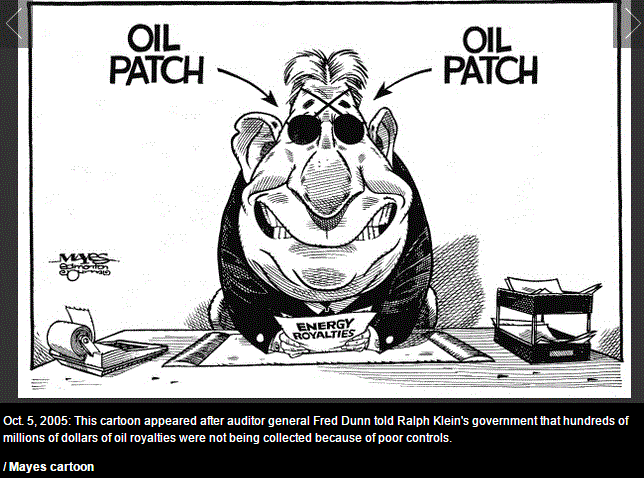Look Out Alberta Teachers! Over $19 Billion in retirement savings for teachers, state troopers and public workers lost over last decade by California & Colorado state pension funds investing in fossil fuels.
Kenney stealing $16.6 Billion from Alberta teachers to give yet more corporate welfare to polluting oil & gas & frac bankrupters via AIMCo?

Malcolm Mayes cartoon in Edmonton Journal, Nov 2019
IT TURNS OUT THE UCP’S DREAM OF GRABBING THE CANADA PENSION PLAN WON’T BE AS EASY AS IT WOULD LIKE YOU TO BELIEVE by David Climenhaga, Nov 11, 2019, Alberta Politics.ca
… It turns out this isn’t as easy to do as the right-wing commentariat would like you to believe. So while Albertans need to remain on guard against Mr. Kenney scheming to hijack their CPP, it’s too early to despair that their pension funds are about to disappear into thin air like 50 years of Alberta’s oil and gas royalties.
… As an aside, any such scheme had better be comparable, or Ottawa should tell the UCP to keep its grubby paws off our pensions.
Unfortunately, this doesn’t apply if you’re an Alberta teacher, nurse or other public employee whose pension savings Mr. Kenney covets for use as a pork barrel to convert into welfare payments for fossil fuel billionaires. …
What it would mean for pensioners if Kenney creates an Alberta pension plan, Pension funds would likely be transferred to government-owned AIMCo by Joel Dryden, Nov 10, 2019, CBC News
5122 comments at time of reading.
Naturally, some questions arise whenever anyone floats the possibility of transferring billions of public dollars from one fund manager to another.
Speaking Saturday during a keynote address to close the Manning Conference in Red Deer, Alberta, Premier Jason Kenney laid out measures that will be explored as part of what’s being called the Fair Deal Panel.
He announced initiatives that include creating a provincial police force, establishing a formal provincial constitution and opting out of federal cost-sharing programs.
The panel will also study the possibility of withdrawing from the Canada Pension Plan (CPP) in favour of an Alberta-based alternative. [No thank you! Alberta govt is controlled by the oil and gas industry, so is AIMCo]
That squares with previous comments Kenney has made on pensions, including during a Facebook livestream a little more than a week ago. In that stream, he said he believed a “compelling case” could be made to withdraw from the CPP.
So were an Alberta pension plan to be implemented, how would a fund transfer take place? Who would manage and invest those funds? And why now? [Because frac’ers are taking their profits and running faster than weasels from henhouse after killing all the chickens]
How would it work? The short answer is: it’s unclear.
Alberta pensioners have been paying into CPP since it was established in 1965 by Prime Minister Lester B. Pearson. The CPP fund has $400.6 billion in assets as of June 30 — money that has been partly contributed by Albertans.
Economist Trevor Tombe said there’s no precedent for what has been proposed by Kenney.
“For Alberta to withdraw from the CPP would be a phenomenally complex undertaking, because you’d have to figure out what share of the fund is transferred to the Alberta fund,” [No math required. Kenney and industry likely want all of it and think they’re entitled to it] Tombe said. “How would people’s CPP contributions and benefits they’ve already earned, how would that translate into an Alberta system?”
It’s possible that the Alberta government could set up a parallel pension system to the CPP and gradually phase out of one and into another, Tombe said.
“But it would be phenomenally complex [to set up]. And I’m not sure what it would achieve,” he said.
In a scenario where the Alberta government was able to transfer the billions in dollars in Alberta pensions to a local authority, those funds would, in all likelihood, be managed by the Alberta Investment Management Corp., or AIMCo.
Who would manage the funds?
AIMCo is a Crown corporation, meaning it is owned by the provincial government.
The corporation already manages $100 billion in government pensions and other funds, and approximately $17 billion in assets as part of the Alberta Heritage Savings Trust Fund. [Which ought to be a $ trillion by now]
According to the corporation’s mandate and roles document, it operates at arms-length from the government but there is “broad cooperation and collaboration between AIMCo and the Government of Alberta.”
Bryce Tingle, a regulatory lawyer and professor at the University of Calgary, said keeping the relationship arms-length was important for a number of reasons.

“It’s good because you want your money to be managed by professionals. You don’t want politicians, who typically don’t have very much training in investment selection, stock picking and trading strategies, to be in charge of banking investments,” Tingle said.
“You also don’t want public money used to reward friends of the politicians or powerful constituencies.”
Though the government wrote in its budget it planned to build up a “made in Alberta” portfolio through AIMCo, a spokesperson said that didn’t mean the corporation would be pressured to use the funds to support provincial initiatives.
“The ‘made in Alberta’ strategy referenced in the budget document ensures that AIMCo retains its position as a leader of investment management services in Western Canada by further solidifying its role and increasing its assets under management,” said Jerrica Goodwin with Alberta’s Treasury Board and Finance in a written statement. “The ‘made in Alberta’ phrasing is not a reference to a change in the way that AIMCo invests their client’s money.”
Were AIMCo to use pension funds to invest in Alberta-based companies and economies that move would likely backfire, Tingle said.
“If AIMCo was to invest preferentially in, let’s say oil and gas, and it was underperforming the rest of the market, so AIMCo reported steady subpar returns, that would eventually become a political football,” Tingle said. “Because that pension money is what Albertans depend on to live on when they stop working.”
Denes Nemeth, director of communications with AIMCo, said the organization would not respond to influence from the provincial government.
“[If] any provincial government directed AIMCo to manage a specific company, a specific asset, a specific type of infrastructure, absolutely not,” he said. “We have full investment discretion over what kinds of investments we make and they need to maximize net investment returns for our clients.”
AIMCo funds achieved a net return of 2.3 per cent in 2018, down from 9.3 per cent a year prior. [Failing to make decent returns because of investments (“loans”) to bad frac’ers?]
A CBC News investigation published in July revealed AIMCo had shares worth a total of about $4.8 million as of March 31, in both GEO Group and CoreCivic, two companies linked to for-profit prison companies, including one linked to controversial migrant detention centres in the United States.
AIMCo confirmed the corporation no longer owned shares in those companies.
Why now?
Discussion around an Alberta pension plan can be traced back to the “firewall letter,” penned by a number of prominent conservative figures, but it has largely fallen off the radar over the past two decades.
But in a time of continued western alienation, Tingle said it could be part of a larger bargaining chip with Ottawa.
“As far as I can see, the threat to withdraw from CPP is actually the most credible tool the provincial government has in its quiver to bring people to the table and negotiate on the things Alberta cares about,” he said.
For Tombe, the panel has its work cut out for it, with no obvious first step forward.
“It would be very complex, and there currently does not exist details or credible analysis on how to do it,” he said. “So at the moment, it’s just a talking point.”
